Thomas Jefferson Rusk is significant in Nacogdoches history for his role as a soldier and politician in the Texas Revolution and the Republic of Texas. To view or print a brochure about Rusk, please click the following link Thomas Jefferson Rusk Brochure or for more information, please continue reading. View information about Rusk's statue on the Statue Trail here
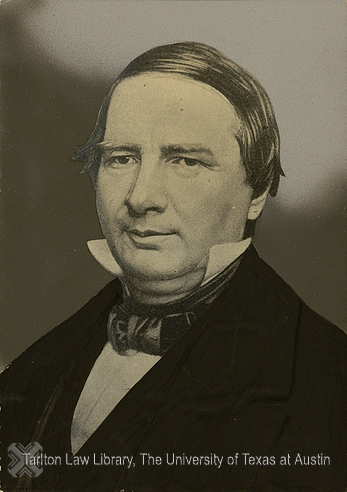
Thomas Jefferson Rusk
"He came upon the stage of human action at a time vibrant with big events and departed when the clouds of disunion and internecine strife hovered like a phantom on the horizon of the future…It is well that the heart of the great soldier and statesman ceased to beat before the clouds of fratricidal strife overspread the land. It is well that he sank to rest in the uplifting hope and belief that the new Republic, his own beloved Texas, had entered upon a career, in which there would be no strife, no discord or animosities, but one, prolonged and happy career."[1]
Thomas Jefferson Rusk was born to John and Mary Rusk on December 5, 1803 in the Pendleton District of South Carolina where the family lived in a home on the property of John C. Calhoun.[2] Calhoun saw something in his young tenant and found him a position in the office of the District Clerk, where he earned a living while studying law.[3] Upon gaining a license to practice law, Rusk left South Carolina, moved to Clarksville, Georgia, and soon rose to prominence and collected some wealth. It was in Clarksville that Thomas Rusk met and married Mary Frances Cleveland, the daughter of a wealthy planter and merchant.[4] According to the family Bible, Thomas J. Rusk and Mary Frances Cleveland were married on Thursday, January 4, 1827.[5] The couple had seven children, Benjamin Livingston, John Cleveland, Thomas Jefferson Jr., Cicero, Alonzo, Thomas David, and Helena Argin. Of those seven, at least two of the children, Thomas Jefferson Jr. and Alonzo, died in childhood.
.jpg)
Mary Frances Cleveland - Rusk
.jpg)
Rusk Family Bible
What Brought TJR to Nacogdoches?
The Clarksville area of Georgia had gold mining operations and Rusk invested everything he owned, plus one thousand dollars borrowed from his father-in-law, in the McLaughlin brothers' operation.[6] The McLaughlins embezzled Rusk's and other investors' funds and fled to Texas.[7] Soon after the birth of their fourth son and death of their third child in 1835, Rusk followed in pursuit, and though he never regained his investment, he did find his new home.[8] It is uncertain how old Rusk was when he arrived in Texas. He stated that he was twenty-nine when he took his oath of allegiance. When he signed the Texas Declaration of Independence, he also listed twenty-nine as his age but according to the family Bible, he should have been thirty-one upon arriving in Texas.[9] On February 11, 1835, Thomas J. Rusk took his oath of allegiance to Mexico before Radford Berry, the alcalde (mayor) of Nacogdoches, Sam Houston, and Nathaniel Robbins. In March of 1835 Rusk became the Attorney-in-Fact for the empressario General John T. Mason. Under this contract, Rusk was allowed to settle four hundred families in Texas. 1835 is also the year that Mary and the couple's three sons moved from Georgia to Texas and settled in The Red House, the former headquarters of Colonel Jose de las Piedras.
.jpg)
The Red House
Rusk and the Texas Revolution
Nacogdoches was full of American and European immigrants who were unhappy with the conditions that were being imposed upon them by the Mexican government.[10] Rusk met Sam Houston and other revolutionary minded men and devoted himself whole-heartedly to the achievement of Texas independence.
Rusk organized volunteers from Nacogdoches, and along with Stephen F. Austin's army, went to the defense of Gonzales.[11] As a captain in the Texas Army, Rusk organized a company of volunteers and marched to San Antonio in October of 1835.[12] After a victory at Concepcion, Rusk and Colonel Fannin were commissioned by the executive council to gather supplies and more men for the war effort. Rusk left his company to return to Nacogdoches to gather supplies and was named Commissariate for the army. It is said that much of the success of the Texas Revolution is due to his wise management of supplies and men passing though Nacogdoches.[13]
Thomas J. Rusk was elected to the Convention of 1836 where he signed the Texas Declaration of Independence. Rusk became the Secretary of War under President David G. Burnet. After assisting the Burnet and provisional government move to Harrisburg, Rusk joined Sam Houston who ordered the Texas Army to march against the Mexican troops that were making their way East after the fall of the Alamo, which resulted in the Battle of San Jacinto.[14] When Sam Houston was wounded in battle, Rusk took up the position of Brigadier General and commanded the Texas Army as it chased the Mexicans out of Texas. On that Palm Sunday, Rusk and his men travelled back to Goliad where they buried Fannin and his men. Rusk spoke over the graves in a speech which was said inspired patriotism, the glory of their accomplishments, and "many a rough and hardy soldier whose eyes had never since childhood been wet with the waters of sorry or sympathy, shed copious tears that day over the half consumed bodies of his comrades."[15]
.jpg)
Thomas J. Rusk Historical Marker located ont he campus of SFA
After the Revolution
Though his friends tried to persuade Rusk to be a presidential candidate, Rusk returned to Nacogdoches to try and live a quiet life with his family, whom he felt that he had neglected, and return to his business, as money was scarce since he had spent so much time away fighting the revolution.[16] In 1836, President Sam Houston appointed Rusk to a seat in his cabinet but he soon resigned to give his attentions to his family and business.[17] In 1837, Rusk was elected to the Second Congress of the Republic of Texas. In 1838, Rusk and one hundred other soldiers chased a group of Kickapoo Indians, who had collaborated in the Cordova Rebellion, into the U.S. going as far as Shreveport, when the American legation in Houston demanded an explanations of his invasion of the U.S. he stated, "Who me? I was just chasing a band of Indians."[18] This action was against orders given by Sam Houston and caused a rift between the friends until they met again in Washington.[19]
In 1839, he was elected by the Congress of the Republic of Texas to the office of Chief Justice of the new government. He held this position for a year before again resigning to attend to private matters.[20] He was good at those things, but was known for his leadership abilities, and he was soon called back to serve the Republic of Texas. In 1843 he was appointed the Brigadier General of the Militia, a position that he held for a year before devoting all of his energy to the annexation of Texas. In 1845 Rusk was elected to be a member of the convention that framed the Constitution of the state and was unanimously voted the President of the Convention. The first Legislature of Texas after its annexation elected Rusk to the Senate of the United States in March of 1846, where he served until the time of his death. He was very influential in the Senate and was the Head of the Committee on Postal Affairs for several terms. According to the 1850 U.S. Census, Rusk continued to practice law and served as the Head of the Bar for the Republic of Texas.[21] During the session of 1855, Rusk served as President Pro Temp of the Senate. In 1856, Rusk was a leading candidate for the Democratic presidential nomination, but he declined to run.[22] Along with all of the offices Rusk held, he also rejected numerous offers including President, Vice President, and Secretary of State of the Republic of Texas.
.jpg)
Thomas J. Rusk Statue
While Rusk was highly thought of and well accomplished, he suffered one of the faults of his day and that was slavery. The 1850 slave schedule lists Rusk as the owner of sixteen slaves ranging in age from two to forty, eight males and eight females, eight of which were black and eight were mulatto.[23]
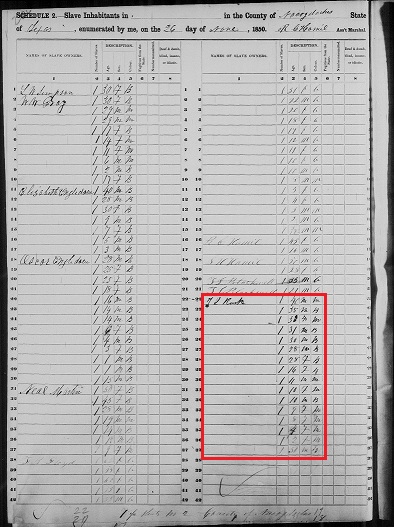
Thomas J. Rusk Entry on the 1950 Nacogdoches Slave Schedule
Memory of Rusk
Thomas J. Rusk's wife Mary began to suffer the effects of consumption in 1856 but would not allow her friends to call Rusk from his work in the Senate because she said, "he is where his duty calls him and I do not wish him sent for until it is really necessary."[24] Once her friends deemed it truly necessary and sent for Rusk, it was too late, and Mary died on April 26, 1856, before he arrived, saying that her only regret was dying without his presence. Friends said that Rusk was never the same after her passing and "seemed to shun the society of people and chose rather to live apart, wrapped in his own meditation."[25] On July 29, 1857 after ordering a gravestone for Mary who had died a year earlier, Rusk, who was suffering from a tumor at the base of his neck, shot himself in the head with his rifle behind his house, where he was discovered by his slave."[26] The public reaction to his death was expressed in his eulogy, which stated,
The manner of his death is the only shade on the grand and brilliant picture of this long, glorious and useful life. He had been weak and sick for some time, the death of his wife had been to him a crushing affliction, his grief acting through the disordered state of his physical condition, produced such an increasing degree of gloom and melancholy, as finally to weaken the control of reason, and in a moment of temporary insanity to produce the melancholy catastrophe which has filled the country with lamentation and woe. Let the tears of sympathy flow for this sudden collapse of one of the finest of mental organizations, striking as it did from the life and from his country forever, one of her most illustrious and venerated patriots and statesmen.[27]
Thirty-seven years after Rusk's death, the Texas Legislature appropriated $1000 for a monument in Oak Grove Cemetery for Rusk.[28] When it was unveiled on September 27, 1894, all businesses and schools in Nacogdoches were closed. At ten o'clock in the morning, the Stone Fort Rifles, a brass band, and a juvenile band led a procession from the town square to the cemetery. Those attending the ceremony included city officials, distinguished visitors, relatives, members of the Daughters of the Republic of Texas, and many others.
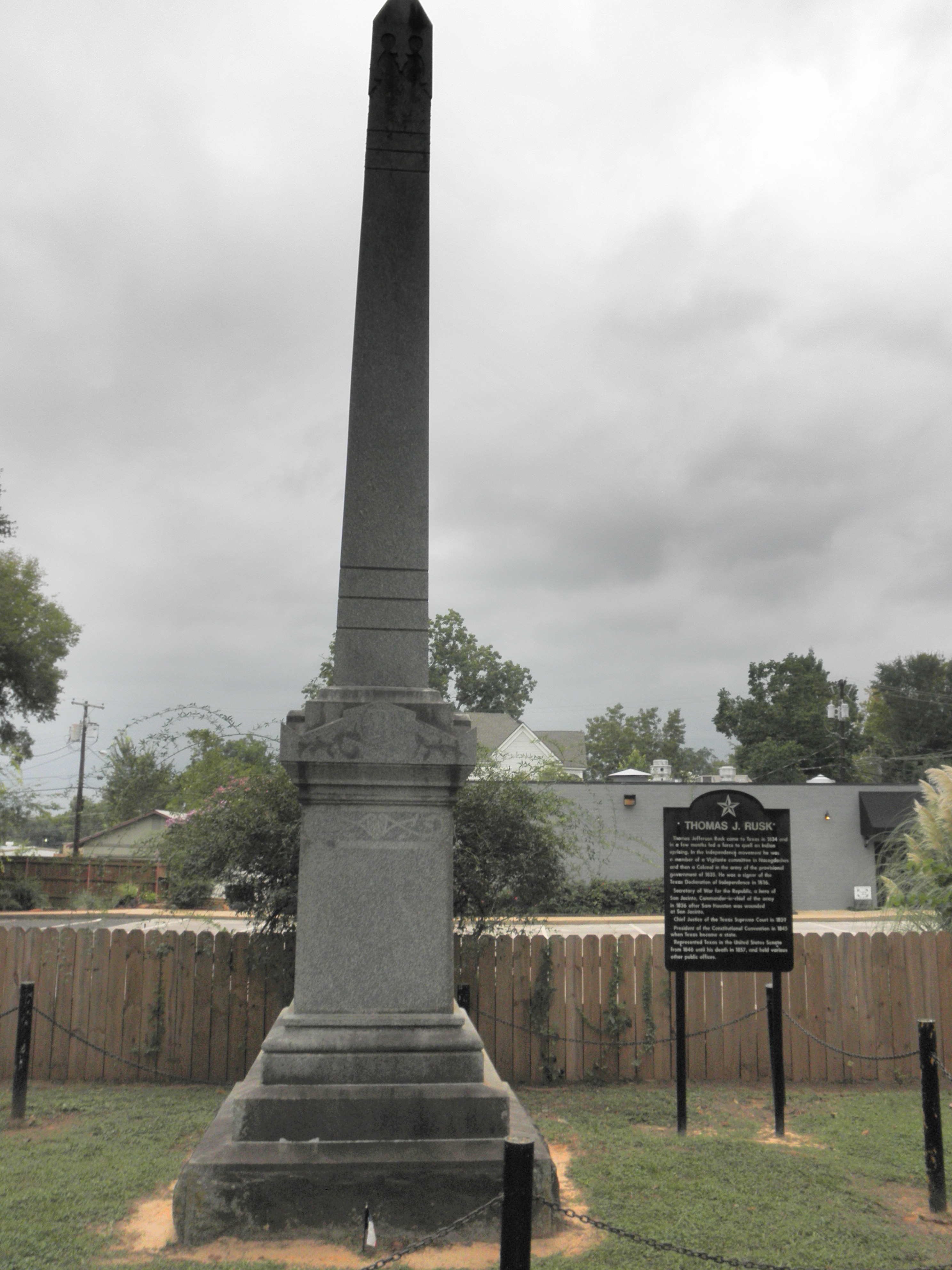
Rusk Memorial at Oak Grove Cemetery
Thomas J. Rusk's grave is located south of the main entrance to Oak Grove Cemetery. Rusk's memorial was erected in 1894 by the State of Texas and is made of gray granite in the shape of an obelisk on a pedestal. On the base of the monument is the seal of the State of Texas and the words "Patriot," "Soldier," "Statesman," "Jurist." The gravesite also contains biographical signage describing Rusk's life and accomplishments. To locate Rusk's grave in Oak Grove Cemetery, visit http://preserveamerica.sfasu.edu/OakGrove/ and enter his name into the search critera.
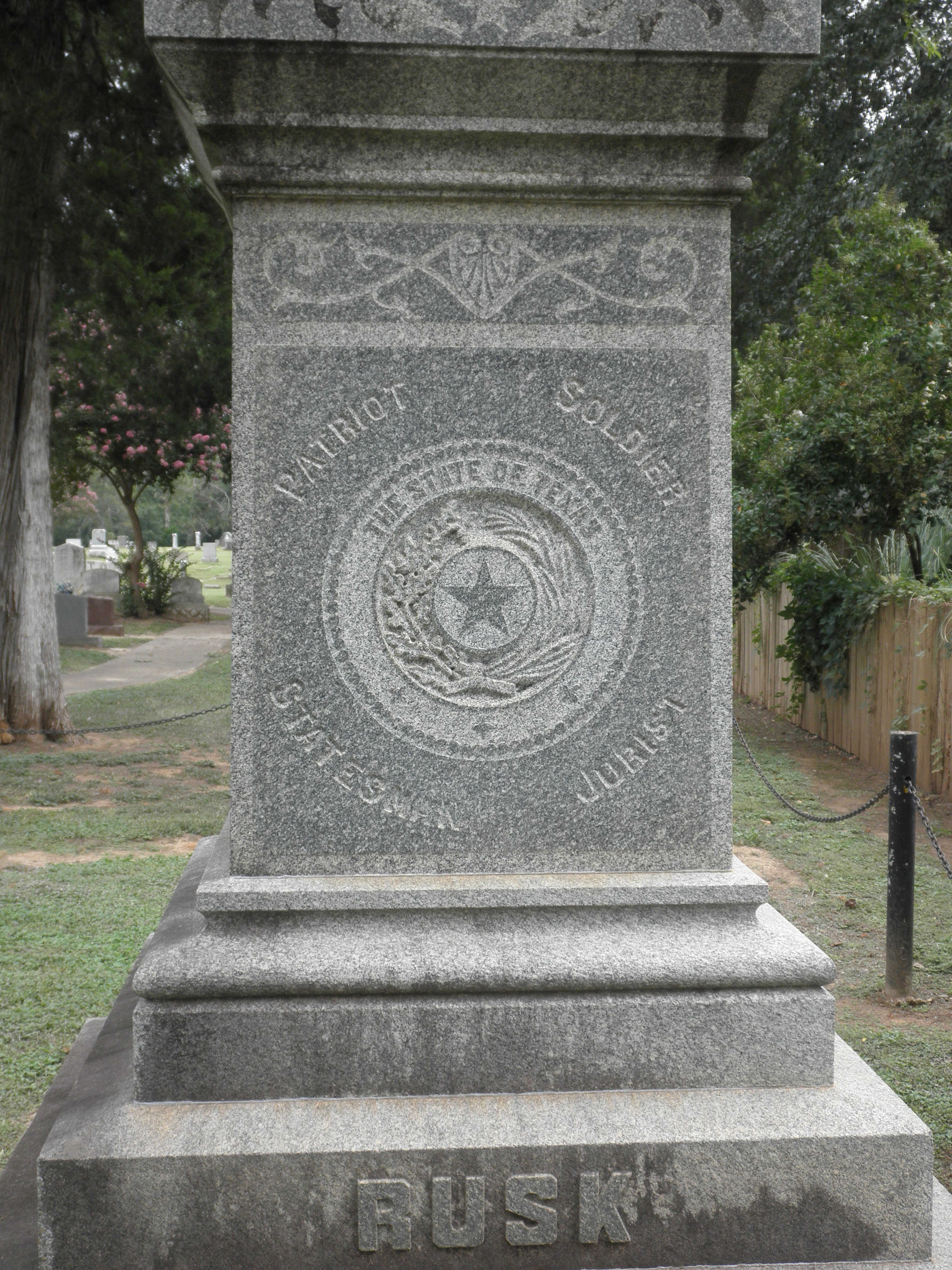
Engraving on Rusk Memorial at Oak Grove Cemetery
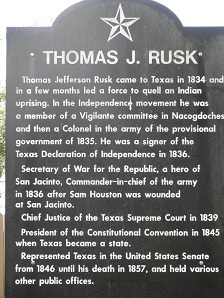
Thomas J. Rusk Signage at Oak Grove Cemetery
The Rusk Homes
The first residence of the Rusk family was The Red House, located in the middle of what is now East Pilar Street between South Pecan and South Street.[30] This home was the former headquarters of Colonel Jose de las Piedras.[29] Rusk represented Piedras in a suit after the revolution and later purchased The Red House, which was sold to satisfy the judgment against Piedras. The family lived in The Red House until their permanent home, "Santo Domingo" was built. The exact date of the home's erection is not known; the deed says November 19, 1855, but the diary of Adolphus Sterne states that the home was built in either 1840 or 1841. It is said that the old Rusk home faced South on what is now called Rusk Street. The original homesite stretched from Lanana to Banita Creek and included what is now the campus of Stephen F. Austin State University.After Rusk's suicide, his son Cicero lived in the family home until he left to fight in the Civil War, from which he never returned. The house was then torn down and some of the materials were used by a Mr. Jordan to build his home, which later burned, and was replaced by the current home, located near the intersection of North and Rusk Streets, constructed by Eugene H. Blount.
.jpg)
Thomas J. Rusk Homesite Marker
.jpg)
Rusk Building Historical Marker on the campus of SFA
Images
- Thomas J. Rusk photograph, "Thomas Jefferson Rusk, Chief Justice, 1838-1840," Jurists Collection, Rare Books & Speical Collections, TJ5/59, Tarleton Law Library, Austin Texas http://tarlton.law.utexas.edu/justices/profile/view/91.
- Thomas J. Rusk Family Bible, Thomas J. Rusk Collection, A136, F12, East Texas Research Center, Stephen F. Austin State University, Nacogdoches, Texas.
- Mary Rusk photograph from "Rusk Came to Catch a Thief, Stayed to Help Make Texas an Empire," Dallas Morning News, February 25, 1940, Vertical File, Biography, ROB-RZ, Thomas J. Rusk, East Texas Research Center, Stephen F. Austin State University, Nacogdoches, Texas.
- The Red House, Vertical File, Nacogdoches County, Historic Preservation, Historic Landmarks and Sites, Red House, East Texas Research Center, Stephen F. Austin State University, Nacogdoches, Texas. A Historical Marker for the Red House is located at 115 South Street, Nacogdoches, Texas.
- Thomas J. Rusk Historical Marker, Located on the campus of Stephen F. Austin State University, Nacogdoches, Texas.
- Thomas J. Rusk Statue, Located at the northeast corner of Main Street and North Street, Nacogdoches, Texas.
- Thomas J. Rusk Entry on 1850 Slave Schedule "United States Census (Slave Schedule), 1850, Nacogdoches," Family Search, pg 17, https://familysearch.ord/pal:/MM9.3.1/TH-267-12391-52628-11?cc=1420440&wc=6145830
- Rusk Memorial, Oak Grove Cemetery, Nacogdoches, Texas.
- Engraving on Rusk Memorial, Oak Grove Cemetery, Nacogdoches, Texas.
- Thomas J. Rusk Signage at Oak Grove Cemetery, Nacogdoches, Texas.
- Site of the Home of Thomas J. Rusk, Located at the northwest corner of Rusk Street and North Street, Nacogdoches, Texas.
- Rusk Building Historical Marker on the campus of Stephen F. Austin State University, Nacogdoches, Texas.
References